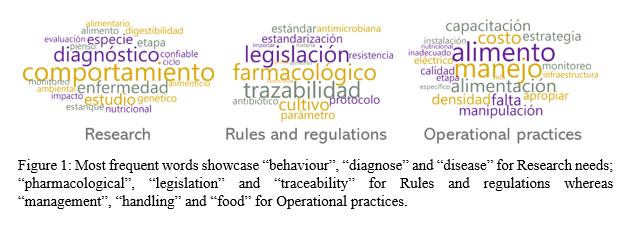PERCEPTION OF CHALLENGES AND NEEDS REGARDING ANIMAL WELFARE IN LATIN AMERICAN AQUACULTURE
Introduction
Animal protein production faces challenges such as intensifying farming practices, boosting feedstuff yields, and reducing environmental impacts to meet UN sustainability goals. Ethical concerns about animal welfare, recognizing animals as sentient beings, have pressured producers, legislators and consumers to adopt humane farming practices. This study examines Latin American aquaculture stakeholders’ perceptions in order to address issues ensuring the four domains of animal welfare: nutrition, environment, behavioural interactions and health freedom fr om hunger, discomfort , pain, and the ability to express normal behaviour.
Methods
Aquaculture stakeholders fr om Latin American Countrie s (scientist, national administrations and private sector) , participated in a 3-days A quatic A nimal Welfare (AAW) workshop within the framework of the CEREBAL project, with a total of 150 respondents . Focus group interviews encouraged participants to respond to the question: what problems can be found in aquatic-animal welfare? across four dimensions ( good nutrition GN, appropriated housing AH , appropriate behaviour AB and good health GH) , aquaculture processes ( developmental stages, culture methods transport and slaughter ) and eight species (tagging responses to research, legislation, or operational practices) . A Latent Dirichlet Allocation (topic modelling analysis), was performed for Spanish words , revealing main topics and the most frequent terms used for describing each dimension and category problems.
Results
Participant’s answers in the developmental stages category highlighted three latent topics: 1) animal-based welfare indicators, 2) feeding strategies, and 3) sanitary conditions. Frequent terms across dimensions included “food”, “stress” and “mortality”, while “cannibalism” was related to early life stages. Reproductive stage emphasized “spawning”, “stress” and “females”, while grow-out stage featured “feeding” and “sanitation”. When comparing different culture systems, the main topics of GN were: 1) the availability of appropriate quality food, 2) food distribution, and 3) feeding strategies, using “distribution”, “food” and “bottom” as more frequent words. The main topics identified in A H dimension were: 1) water quality and density, 2) environmental variables and 3) predator entry to the facility. The words “density” and “environmental” and “predator” were prevalent in all categories. The GH dimension featured: 1) availability of veterinary healthcare, 2) water control, 3) disease control and appropriate diagnose, as main topics. The most frequent words used within these topics included: “difficulty”, “diagnose”, “control”, “pathogen” and “presence”. Recirculating Aquaculture Systems included “correct”, “veterinary” and “treatment”, whereas the floating cages systems related more to “presence”, “environmental” and “disease”. The AB dimension answers , according to culture systems, showed: 1) behaviour assessment, 2) appropriate facilities and 3) natural behaviour in production; as the most relevant topics. Wo rds choice indicated general and ambiguous responses, suggesting limited participant knowledge. Main topics in the slaughter methods category featured : 1) c apacity building, 2) avoid stress, suffering and pain during procedures, 3) procedures in tanks may cause suffering and stress. “T raining” (as in capacity building) was the leading word across responses and dimensions. The GN included words such as “fastening” and “stress”. The words “t ank” and “overcrowding” appeared recurrently in AH . AB included “method” and “protocol”, whereas GH included “stress”, “suffering” and “pain” . Slaughter methods featured words as : “type”, “adequate” “concentration” ( for anaesthesia) ; “need”, “effectiveness” and “training” (electric shock) ; “suffering”, “procedure” and “protocol” ( for ice). The responses to species-specific problems showed the need to develop welfare indicators based on the animal. It showcased topics such as 1) nutritional needs, 2) species- specific behaviour, 3) feeding strategies and 4) disease diagnose. The n eeds for research include: nutrition and feeding, behaviour, stress, water management and environment. Rules and regulations should address key aspects on: food, production facilities, animal health, capacity building and environmental impact. Operational practices showed: management and animal handling, standardized protocols, personnel training and comprehensive guidance documents . The most frequent words used are displayed in Fig.1.
Discussion and Conclusion
In general, Latin- American stakeholders show concern of topics mainly related to increase sustainability in their process, and a deep need to develop theoretical and technical abilities to address issues related to welfare concerns such as stress, pain and suffering . As each species has unique needs and challenges, it is necessary to establish interventions that result in effectively distinguish the best conditions for improving welfare (1) . We hope that these data can raise awareness of A quatic A nimal Welfare issues and promote innovation and development to address local issues and be translated into laws and guidelines that guarantee the welfare of farmed aquatic organisms.
References:
1.- Zhang, et. al. (2022). Reviews in Aquaculture, 14(3), 1120-1135.
Co-funded by CEREBAL project (CSIC-AECID) INTER23001 and the Spanish government through the “Severo Ochoa Center of Excellence” accreditation (CEX2019-000928-S).
